seats MERCEDES-BENZ GLC 2019 Owners Manual
[x] Cancel search | Manufacturer: MERCEDES-BENZ, Model Year: 2019, Model line: GLC, Model: MERCEDES-BENZ GLC 2019Pages: 370, PDF Size: 19.55 MB
Page 4 of 370
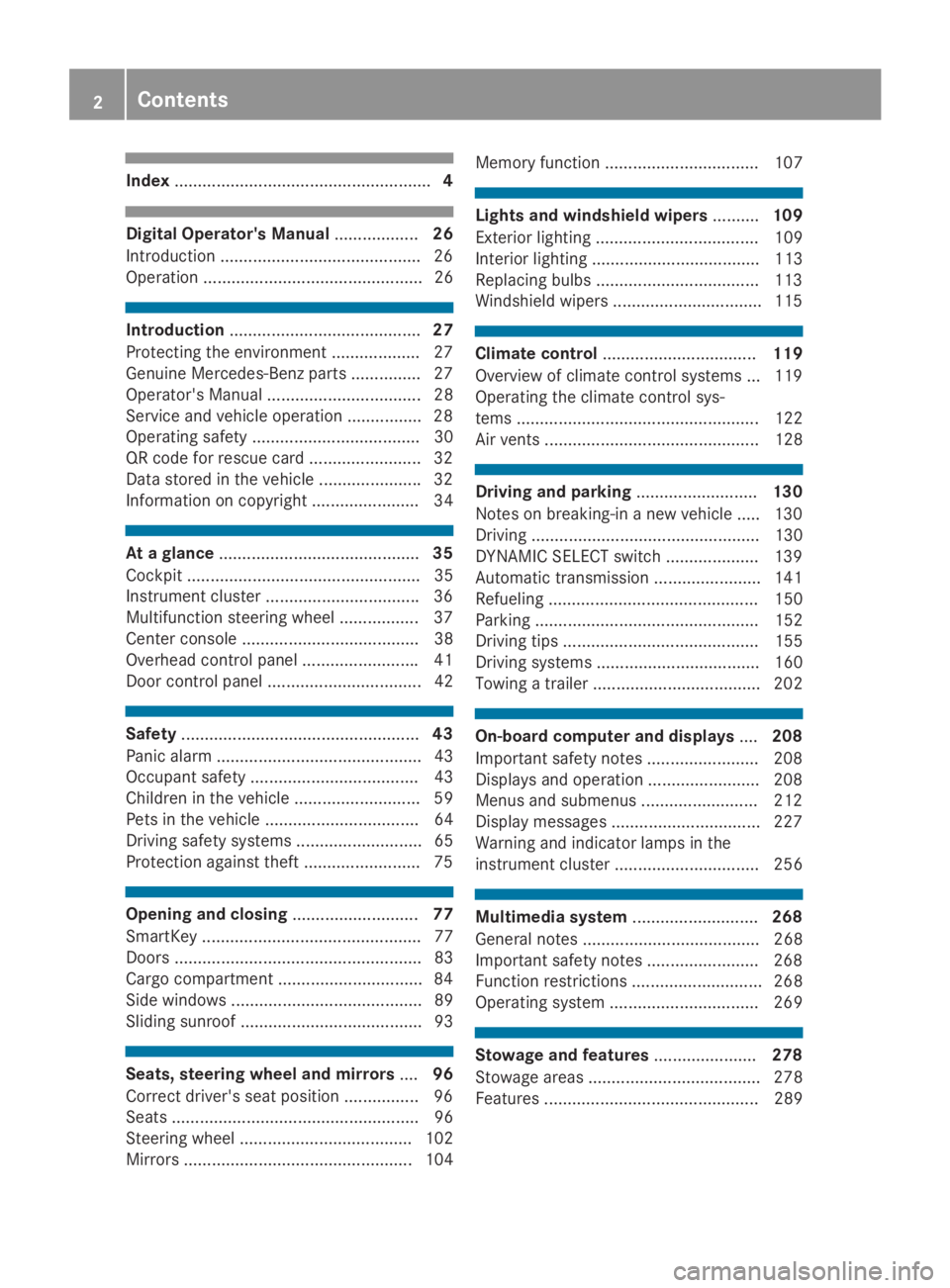
Index.......................................................4
Digital Operator's Manual..................26
Introduction ...........................................26
Operation ............................................... 26
Introduction.........................................27
Protecting the environment ...................27
Genuine Mercedes-Benz parts ...............27
Operator's Manual ................................. 28
Service and vehicle operation ................28
Operating safety .................................... 30
QR code for rescue card ........................ 32
Data stored in the vehicle ......................32
Information on copyright ....................... 34
At a glance...........................................35
Cockpit .................................................. 35
Instrument cluster .................................36
Multifunction steering wheel ................. 37
Center console ...................................... 38
Overhead control panel .........................41
Door control panel ................................. 42
Safety...................................................43
Panic alarm ............................................ 43
Occupant safety .................................... 43
Children in the vehicle ........................... 59
Pets in the vehicle ................................. 64
Driving safety systems ........................... 65
Protection against theft .........................75
Opening and closing...........................77
SmartKey ............................................... 77
Doors ..................................................... 83
Cargo compartment ...............................84
Side windows ......................................... 89
Sliding sunroof ....................................... 93
Seats, steering wheel and mirrors....96
Correct driver's seat position ................ 96
Seats ..................................................... 96
Steering wheel ..................................... 102
Mirrors ................................................. 104
Memory function ................................. 107
Lights and windshield wipers..........109
Exterior lighting ................................... 109
Interior lighting .................................... 113
Replacing bulbs ................................... 113
Windshield wipers ................................ 115
Climate control.................................119
Overview of climate control systems ... 119
Operating the climate control sys-
tems .................................................... 122
Air vents .............................................. 128
Driving and parking..........................130
Notes on breaking-in a new vehicle ..... 130
Driving ................................................. 130
DYNAMIC SELECT switch .................... 139
Automatic transmission ....................... 141
Refueling ............................................. 150
Parking ................................................ 152
Driving tips .......................................... 155
Driving systems ................................... 160
Towing a trailer .................................... 202
On-board computer and displays....208
Important safety notes ........................ 208
Displays and operation ........................ 208
Menus and submenus ......................... 212
Display messages ................................ 227
Warning and indicator lamps in the
instrument cluster ............................... 256
Multimedia system...........................268
General notes ...................................... 268
Important safety notes ........................ 268
Function restrictions ............................ 268
Operating system ................................ 269
Stowage and features......................278
Stowage areas ..................................... 278
Features .............................................. 289
2Contents
Page 17 of 370
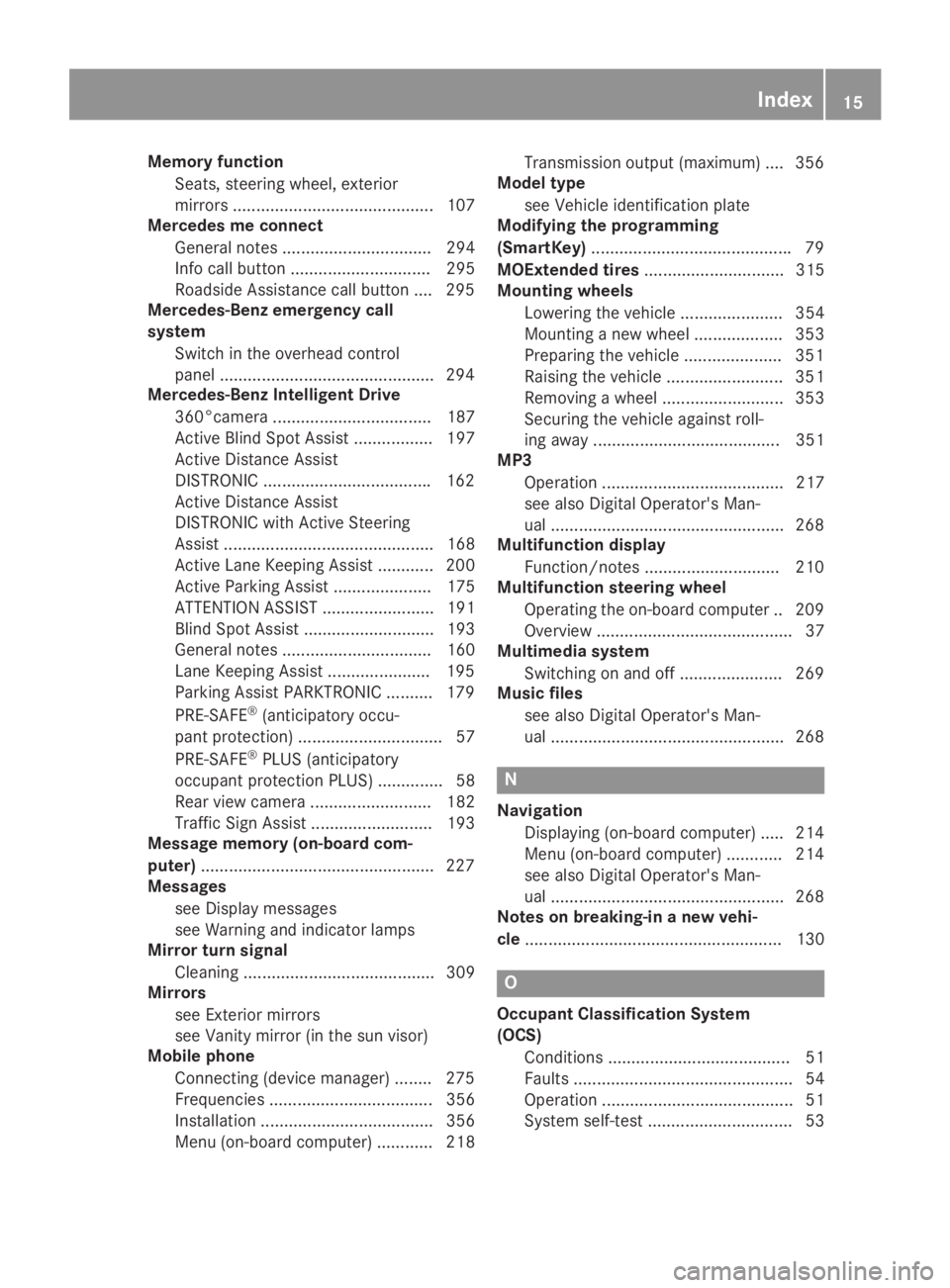
Memory function
Seats, steering wheel, exterior
mirrors ........................................... 107
Mercedes me connect
General notes ................................ 294
Info call button .............................. 295
Roadside Assistance call button .... 295
Mercedes-Benz emergency call
system
Switch in the overhead control
panel ..............................................294
Mercedes-Benz Intelligent Drive
360°camera .................................. 187
Active Blind Spot Assist ................. 197
Active Distance Assist
DISTRONIC ....................................162
Active Distance Assist
DISTRONIC with Active Steering
Assist ............................................. 168
Active Lane Keeping Assist ............ 200
Active Parking Assist ..................... 175
ATTENTION ASSIST ........................ 191
Blind Spot Assist ............................ 193
General notes ................................ 160
Lane Keeping Assist ......................195
Parking Assist PARKTRONIC .......... 179
PRE-SAFE®(anticipatory occu-
pant protection) ............................... 57
PRE-SAFE®PLUS (anticipatory
occupant protection PLUS) .............. 58
Rear view camera .......................... 182
Traffic Sign Assist .......................... 193
Message memory (on-board com-
puter)..................................................227
Messages
see Display messages
see Warning and indicator lamps
Mirror turn signal
Cleaning ......................................... 309
Mirrors
see Exterior mirrors
see Vanity mirror (in the sun visor)
Mobile phone
Connecting (device manager) ........275
Frequencies ................................... 356
Installation ..................................... 356
Menu (on-board computer) ............ 218
Transmission output (maximum) .... 356
Model type
see Vehicle identification plate
Modifying the programming
(SmartKey)...........................................79
MOExtended tires.............................. 315
Mounting wheels
Lowering the vehicle ...................... 354
Mounting a new wheel ................... 353
Preparing the vehicle .....................351
Raising the vehicle ......................... 351
Removing a wheel .......................... 353
Securing the vehicle against roll-
ing away ........................................ 351
MP3
Operation ....................................... 217
see also Digital Operator's Man-
ual ..................................................268
Multifunction display
Function/notes .............................210
Multifunction steering wheel
Operating the on-board computer .. 209
Overview .......................................... 37
Multimedia system
Switching on and off ......................269
Music files
see also Digital Operator's Man-
ual ..................................................268
N
Navigation
Displaying (on-board computer) ..... 214
Menu (on-board computer) ............ 214
see also Digital Operator's Man-
ual ..................................................268
Notes on breaking-in a new vehi-
cle....................................................... 130
O
Occupant Classification System
(OCS)
Conditions ....................................... 51
Faults ............................................... 54
Operation ......................................... 51
System self-test ............................... 53
Index15
Page 20 of 370

Setting the temperature ................ 123
Rear fog lamp
Display message ............................ 239
Switching on/off........................... 110
Rear seat (folding the backrest for-
wards/back)...................................... 281
Rear seat backrest
Display message ............................ 254
Rear seats
Display message ............................ 254
Rear view camera
"Reverse parking" function ............ 184
Cleaning instructions ..................... 309
Coupling up a trailer function ........ 186
Display in the multimedia system .. 183
General notes ................................ 182
Object detection (function/
notes)............................................ 186
Switching on/off........................... 183
Wide-angle function ....................... 186
Rear window defroster
Problem (malfunction) ................... 126
Switching on/off........................... 125
Rear-view mirror
Dipping (automatic) ....................... 105
Recuperation display........................ 213
Reflective safety jacket.................... 313
Refrigerant (air-conditioning sys-
tem)
Important safety notes .................. 362
Refueling
Fuel gauge....................................... 36
Important safety notes .................. 150
Refueling process .......................... 151
see Fuel
Remote control
Garage door opener ....................... 295
Programming (garage door
opener) .......................................... 296
Replacing bulbs
High-beam headlamps................... 114
Important safety notes .................. 113
Installing/removing the cover
(front wheel arch) .......................... 115
Low-beam headlamps.................... 114
Overview of bulb types .................. 114
Replacing front bulbs (vehicles
with halogen headlamps) ............... 114
Turn signals (front) ......................... 115
Reporting safety defects.................... 31
Rescue card......................................... 32
Reserve (fuel tank)
see Fuel
Reserve fuel
Display message ............................ 243
Warning lamp ................................. 262
Residual heat (climate control)........ 126
Restraint system
Display message ............................ 235
Introduction ..................................... 43
Warning lamp ................................. 262
Warning lamp (function) ................... 44
Reversing feature
Side windows ................................... 90
Sliding sunroof ................................. 93
Tailgate ............................................ 85
Roadside Assistance (breakdown).... 29
Roll away protection
see HOLD function
Roller sunblind
Rear side windows......................... 290
Roof carrier........................................ 288
Roof lining and carpets (cleaning
guidelines)......................................... 312
Roof load (maximum)........................ 363
Route guidance
see also Digital Operator's Man-
ual .................................................. 268
Route guidance active...................... 214
S
Safety
Children in the vehicle ..................... 59
see Occupant safety
see Operating safety
Safety system
see Driving safety systems
SD card
Inserting/removing ........................ 276
Selecting ........................................ 217
SD memory card
see also Digital Operator's Man-
ual.................................................. 268
18Index
Page 21 of 370
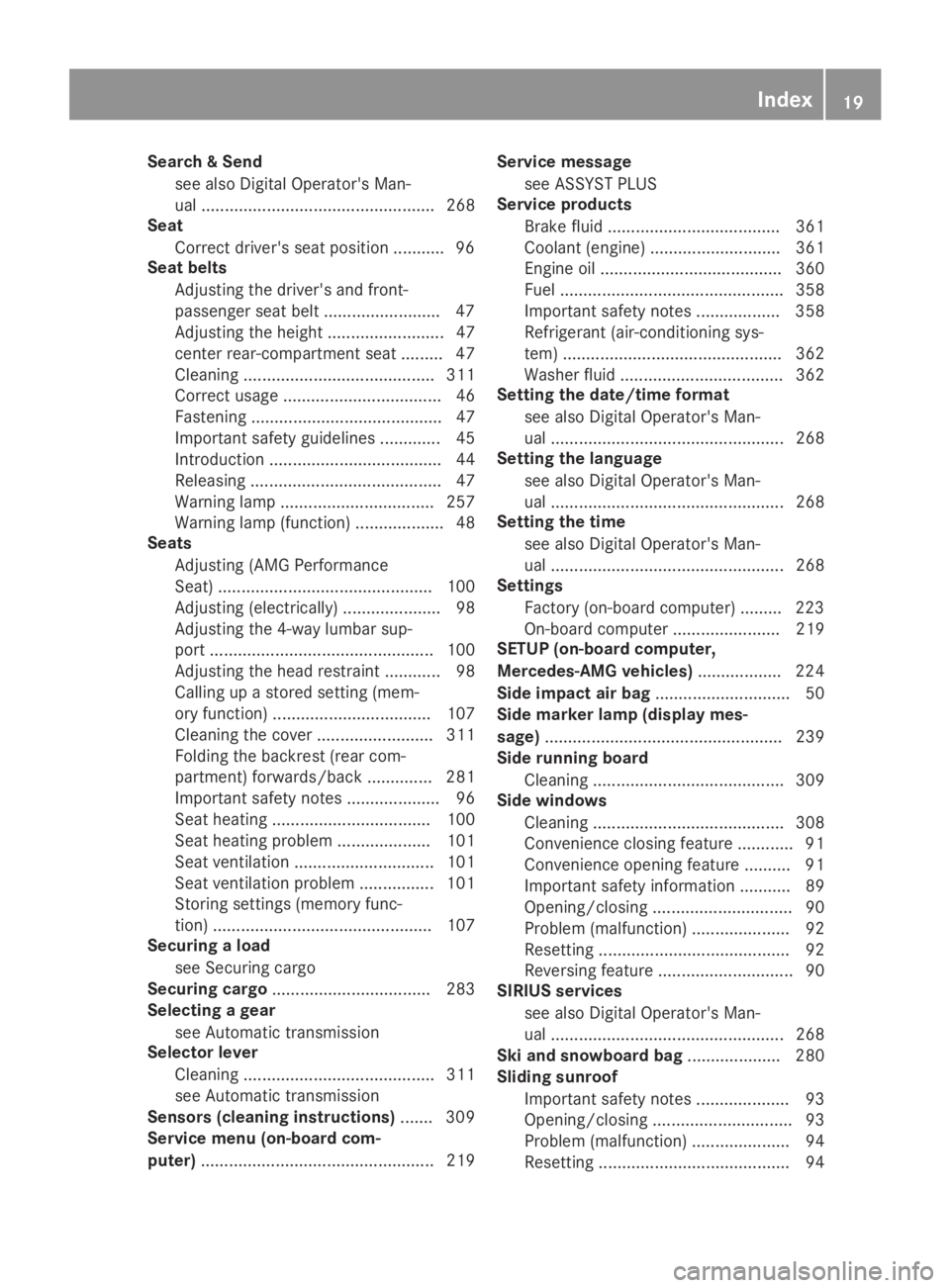
Search & Send
see also Digital Operator's Man-
ual .................................................. 268
Seat
Correct driver's seat position ........... 96
Seat belts
Adjusting the driver's and front-
passenger seat belt .........................47
Adjusting the height ......................... 47
center rear-compartment seat......... 47
Cleaning ......................................... 311
Correct usage .................................. 46
Fastening ......................................... 47
Important safety guidelines ............. 45
Introduction ..................................... 44
Releasing ......................................... 47
Warning lamp ................................. 257
Warning lamp (function) ................... 48
Seats
Adjusting (AMG Performance
Seat) .............................................. 100
Adjusting (electrically) ..................... 98
Adjusting the 4-way lumbar sup-
port ................................................ 100
Adjusting the head restraint ............ 98
Calling up a stored setting (mem-
ory function) .................................. 107
Cleaning the cover ......................... 311
Folding the backrest (rear com-
partment) forwards/back .............. 281
Important safety notes .................... 96
Seat heating .................................. 100
Seat heating problem .................... 101
Seat ventilation .............................. 101
Seat ventilation problem ................ 101
Storing settings (memory func-
tion) ............................................... 107
Securing a load
see Securing cargo
Securing cargo.................................. 283
Selecting a gear
see Automatic transmission
Selector lever
Cleaning ......................................... 311
see Automatic transmission
Sensors (cleaning instructions)....... 309
Service menu (on-board com-
puter).................................................. 219
Service message
see ASSYST PLUS
Service products
Brake fluid ..................................... 361
Coolant (engine) ............................ 361
Engine oil ....................................... 360
Fuel ................................................ 358
Important safety notes .................. 358
Refrigerant (air-conditioning sys-
tem) ............................................... 362
Washer fluid ................................... 362
Setting the date/time format
see also Digital Operator's Man-
ual .................................................. 268
Setting the language
see also Digital Operator's Man-
ual .................................................. 268
Setting the time
see also Digital Operator's Man-
ual .................................................. 268
Settings
Factory (on-board computer) ......... 223
On-board computer ....................... 219
SETUP (on-board computer,
Mercedes-AMG vehicles).................. 224
Side impact air bag............................. 50
Side marker lamp (display mes-
sage)................................................... 239
Side running board
Cleaning ......................................... 309
Side windows
Cleaning ......................................... 308
Convenience closing feature ............ 91
Convenience opening feature .......... 91
Important safety information ........... 89
Opening/closing .............................. 90
Problem (malfunction) ..................... 92
Resetting ......................................... 92
Reversing feature ............................. 90
SIRIUS services
see also Digital Operator's Man-
ual .................................................. 268
Ski and snowboard bag.................... 280
Sliding sunroof
Important safety notes .................... 93
Opening/closing .............................. 93
Problem (malfunction) ..................... 94
Resetting ......................................... 94
Index19
Page 47 of 370
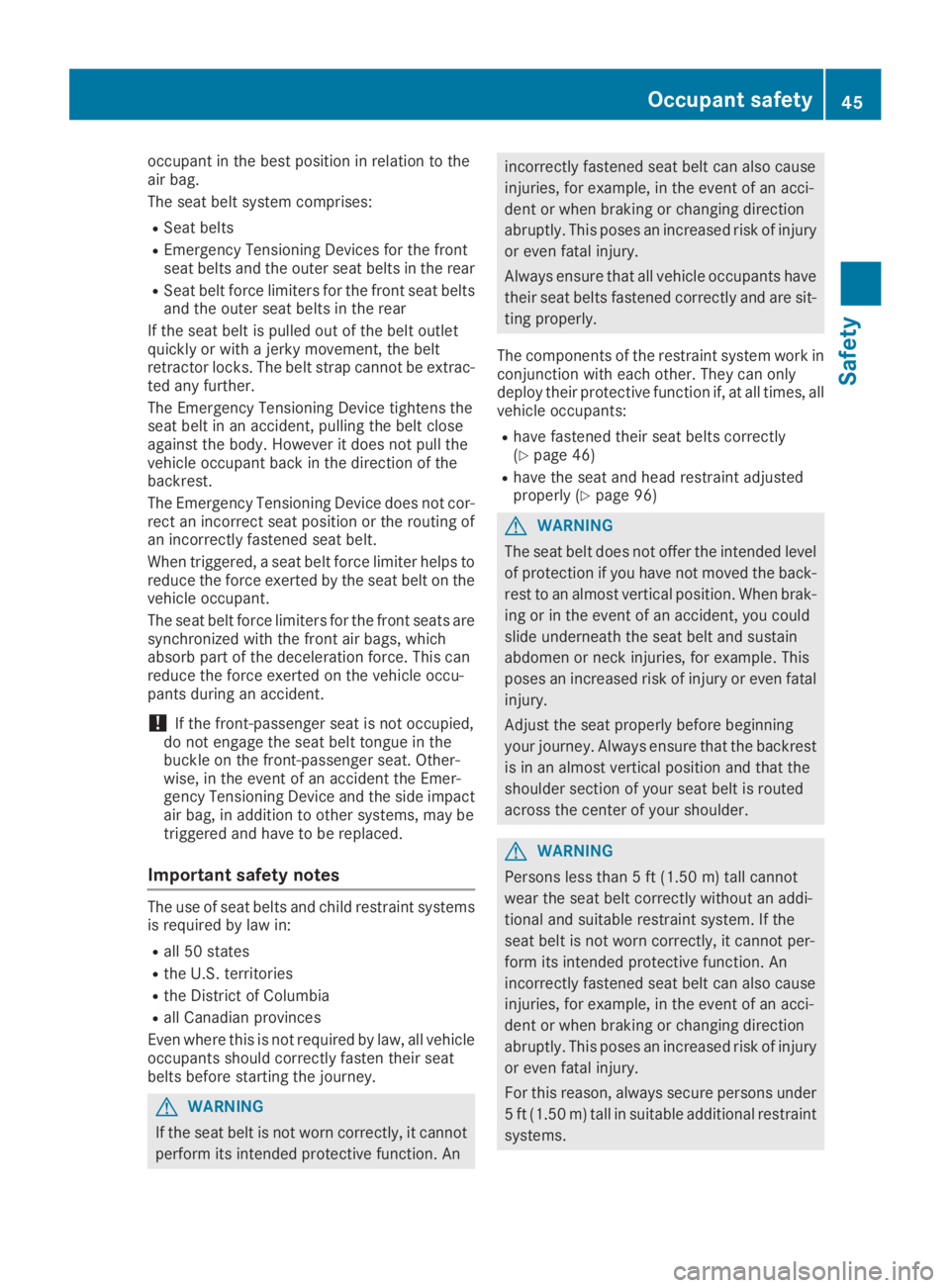
occupant in the best position in relation to theair bag.
The seat belt system comprises:
RSeat belts
REmergency Tensioning Devices for the frontseat belts and the outer seat belts in the rear
RSeat belt force limiters for the front seat beltsand the outer seat belts in the rear
If the seat belt is pulled out of the belt outletquickly or with a jerky movement, the beltretractor locks. The belt strap cannot be extrac-ted any further.
The Emergency Tensioning Device tightens theseat belt in an accident, pulling the belt closeagainst the body. However it does not pull thevehicle occupant back in the direction of thebackrest.
The Emergency Tensioning Device does not cor-rect an incorrect seat position or the routing ofan incorrectly fastened seat belt.
When triggered, a seat belt force limiter helps toreduce the force exerted by the seat belt on thevehicle occupant.
The seat belt force limiters for the front seats aresynchronized with the front air bags, whichabsorb part of the deceleration force. This canreduce the force exerted on the vehicle occu-pants during an accident.
!If the front-passenger seat is not occupied,do not engage the seat belt tongue in thebuckle on the front-passenger seat. Other-wise, in the event of an accident the Emer-gency Tensioning Device and the side impactair bag, in addition to other systems, may betriggered and have to be replaced.
Important safety notes
The use of seat belts and child restraint systemsis required by law in:
Rall 50 states
Rthe U.S. territories
Rthe District of Columbia
Rall Canadian provinces
Even where this is not required by law, all vehicleoccupants should correctly fasten their seatbelts before starting the journey.
GWARNING
If the seat belt is not worn correctly, it cannot
perform its intended protective function. An
incorrectly fastened seat belt can also cause
injuries, for example, in the event of an acci-
dent or when braking or changing direction
abruptly. This poses an increased risk of injury
or even fatal injury.
Always ensure that all vehicle occupants have
their seat belts fastened correctly and are sit-
ting properly.
The components of the restraint system work inconjunction with each other. They can onlydeploy their protective function if, at all times, allvehicle occupants:
Rhave fastened their seat belts correctly(Ypage 46)
Rhave the seat and head restraint adjustedproperly (Ypage 96)
GWARNING
The seat belt does not offer the intended level
of protection if you have not moved the back-
rest to an almost vertical position. When brak-
ing or in the event of an accident, you could
slide underneath the seat belt and sustain
abdomen or neck injuries, for example. This
poses an increased risk of injury or even fatal
injury.
Adjust the seat properly before beginning
your journey. Always ensure that the backrest
is in an almost vertical position and that the
shoulder section of your seat belt is routed
across the center of your shoulder.
GWARNING
Persons less than 5 ft (1.50 m) tall cannot
wear the seat belt correctly without an addi-
tional and suitable restraint system. If the
seat belt is not worn correctly, it cannot per-
form its intended protective function. An
incorrectly fastened seat belt can also cause
injuries, for example, in the event of an acci-
dent or when braking or changing direction
abruptly. This poses an increased risk of injury
or even fatal injury.
For this reason, always secure persons under
5 ft (1.50 m) tall in suitable additional restraint
systems.
Occupant safety45
Safety
Z
Page 50 of 370

The seat belt adjustment will apply a certaintightening force if any slack is detected betweenthe vehicle occupant and the seat belt. Do notgrab hold of the seat belt.
You can switch the seat belt adjustment on andoff using the multimedia system. Information onswitching the seat belt adjustment on and offcan be found in the Digital Operating Instruc-tions.
Belt warning for the driver and front
passenger
The�vseat belt warning lamp in the instru-ment cluster is a reminder that all vehicle occu-pants must wear their seat belts. It may light upcontinuously or flash. In addition, there may bea warning tone.
Regardless of whether the driver's seat belt hasalready been fastened, the�vseat belt warn-ing lamp lights up for six seconds each time theengine is started. If the front doors are closedand the driver's or front-passenger seat belt hasnot been fastened, the�vseat belt warninglamp lights up again after the six seconds. Assoon as the driver's and front-passenger seatbelts are fastened or a front door is openedagain, the�vseat belt warning lamp goes out.
If the driver's seat belt is not fastened after theengine is started, an additional warning tone willsound. The warning tone switches off after sixseconds or once the driver's seat belt is fas-tened.
If the vehicle's speed exceeds 15 mph(25 km/h)once and the driver's and front-passenger seat belts are not fastened, a warningtone sounds. A warning tone also sounds withincreasing intensity for 60 seconds or until thedriver or front passenger have fastened theirseat belts.
If the driver or front passenger unfasten theirseat belts during the journey, the seat belt warn-ing is activated again.
Air bags
Introduction
The installation point of an air bag can be rec-ognized by the AIRBAG marking.
An air bag complements the correctly fastenedseat belt. It is no substitute for the seat belt. The
air bag provides additional protection in appli-cable accident situations.
Not all air bags are deployed in an accident. Thedifferent air bag systems function independ-ently from one another (Ypage 55).
However, no system available today can com-pletely eliminate injuries and fatalities.
It is also not possible to rule out a risk of injurycaused by an air bag due to the high speed atwhich the air bag must be deployed.
Important safety notes
GWARNING
If you do not sit in the correct seat position,
the air bag cannot protect as intended and
could even cause additional injury when
deployed. This poses an increased risk of
injury or even fatal injury.
To avoid hazardous situations, always make
sure that all of the vehicle's occupants:
Rhave fastened their seat belts correctly,
including pregnant women
Rare sitting correctly and maintain the great-
est possible distance to the air bags
Rfollow the following instructions
Always make sure that there are no objects
between the air bag and the vehicle's occu-
pants.
RAdjust the seats properly before beginningyour journey. Always make sure that the seatis in an almost upright position. The center ofthe head restraint must support the head atabout eye level.
RMove the driver's and front-passenger seatsas far back as possible. The driver's seat posi-tion must allow the vehicle to be driven safely.
ROnly hold the steering wheel on the outside.This allows the air bag to be fully deployed.
RAlways lean against the backrest while driv-ing. Do not lean forward or lean against thedoor or side window. You may otherwise be inthe deployment area of the air bags.
RAlways keep your feet in the footwell in frontof the seat. Do not put your feet on the dash-
48Occupant safety
Safety
Page 51 of 370
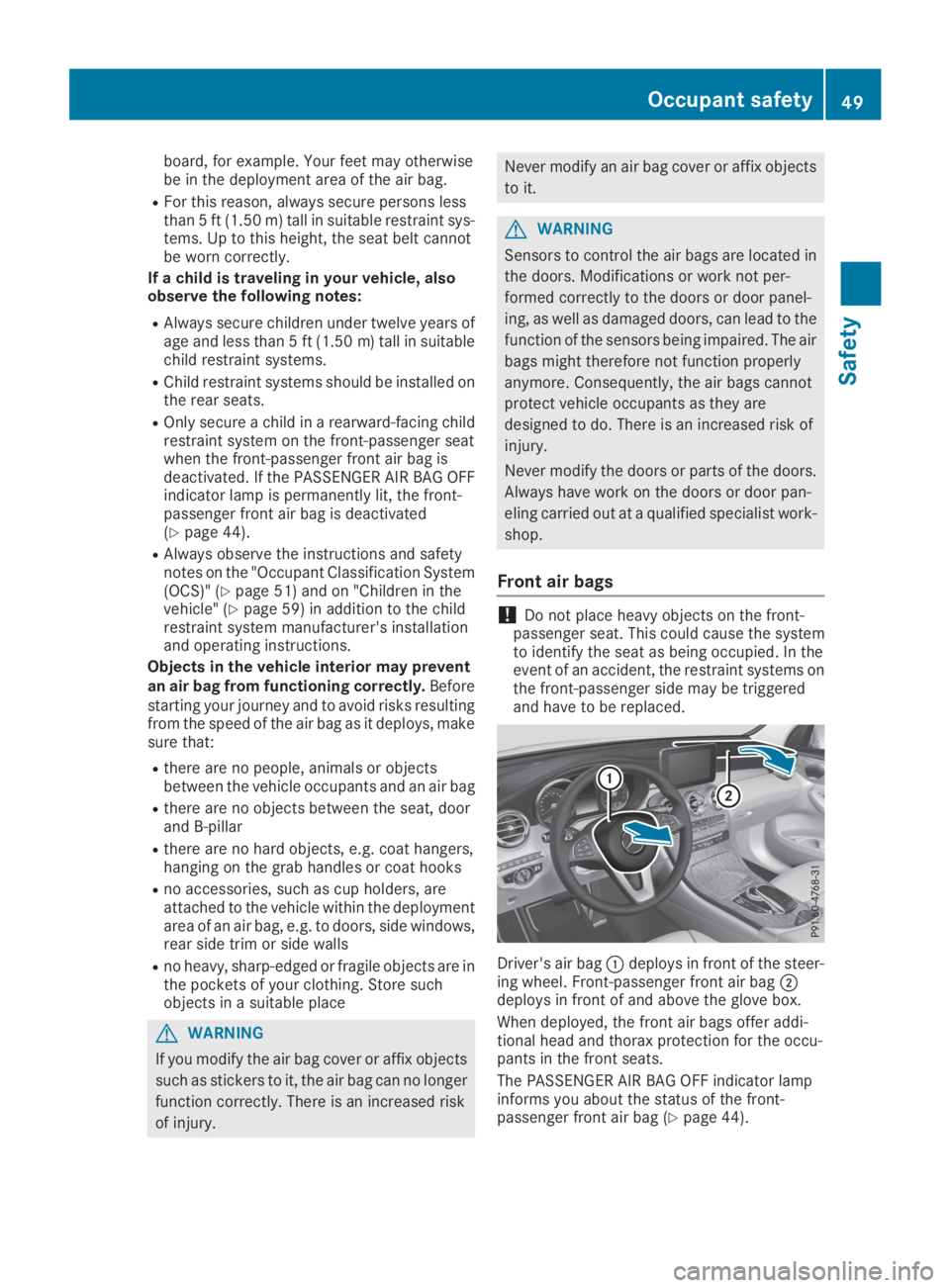
board, for example. Your feet may otherwisebe in the deployment area of the air bag.
RFor this reason, always secure persons lessthan 5 ft (1.50 m) tall in suitable restraint sys-tems. Up to this height, the seat belt cannotbe worn correctly.
If a child is traveling in your vehicle, alsoobserve the following notes:
RAlways secure children under twelve years ofage and less than 5 ft (1.50m)tall in suitablechild restraint systems.
RChild restraint systems should be installed onthe rear seats.
ROnly secure a child in a rearward-facing childrestraint system on the front-passenger seatwhen the front-passenger front air bag isdeactivated. If the PASSENGER AIR BAG OFFindicator lamp is permanently lit, the front-passenger front air bag is deactivated(Ypage 44).
RAlways observe the instructions and safetynotes on the "Occupant Classification System(OCS)" (Ypage 51) and on "Children in thevehicle" (Ypage 59) in addition to the childrestraint system manufacturer's installationand operating instructions.
Objects in the vehicle interior may preventan air bag from functioning correctly.Beforestarting your journey and to avoid risks resultingfrom the speed of the air bag as it deploys, makesure that:
Rthere are no people, animals or objectsbetween the vehicle occupants and an air bag
Rthere are no objects between the seat, doorand B-pillar
Rthere are no hard objects, e.g. coat hangers,hanging on the grab handles or coat hooks
Rno accessories, such as cup holders, areattached to the vehicle within the deploymentarea of an air bag, e.g. to doors, side windows,rear side trim or side walls
Rno heavy, sharp-edged or fragile objects are inthe pockets of your clothing. Store suchobjects in a suitable place
GWARNING
If you modify the air bag cover or affix objects
such as stickers to it, the air bag can no longer
function correctly. There is an increased risk
of injury.
Never modify an air bag cover or affix objects
to it.
GWARNING
Sensors to control the air bags are located in
the doors. Modifications or work not per-
formed correctly to the doors or door panel-
ing, as well as damaged doors, can lead to the
function of the sensors being impaired. The air
bags might therefore not function properly
anymore. Consequently, the air bags cannot
protect vehicle occupants as they are
designed to do. There is an increased risk of
injury.
Never modify the doors or parts of the doors.
Always have work on the doors or door pan-
eling carried out at a qualified specialist work-
shop.
Front air bags
!Do not place heavy objects on the front-passenger seat. This could cause the systemto identify the seat as being occupied. In theevent of an accident, the restraint systems onthe front-passenger side may be triggeredand have to be replaced.
Driver's air bag�Cdeploys in front of the steer-ing wheel. Front-passenger front air bag�Ddeploys in front of and above the glove box.
When deployed, the front air bags offer addi-tional head and thorax protection for the occu-pants in the front seats.
The PASSENGER AIR BAG OFF indicator lampinforms you about the status of the front-passenger front air bag (Ypage 44).
Occupant safety49
Safety
Z
Page 52 of 370
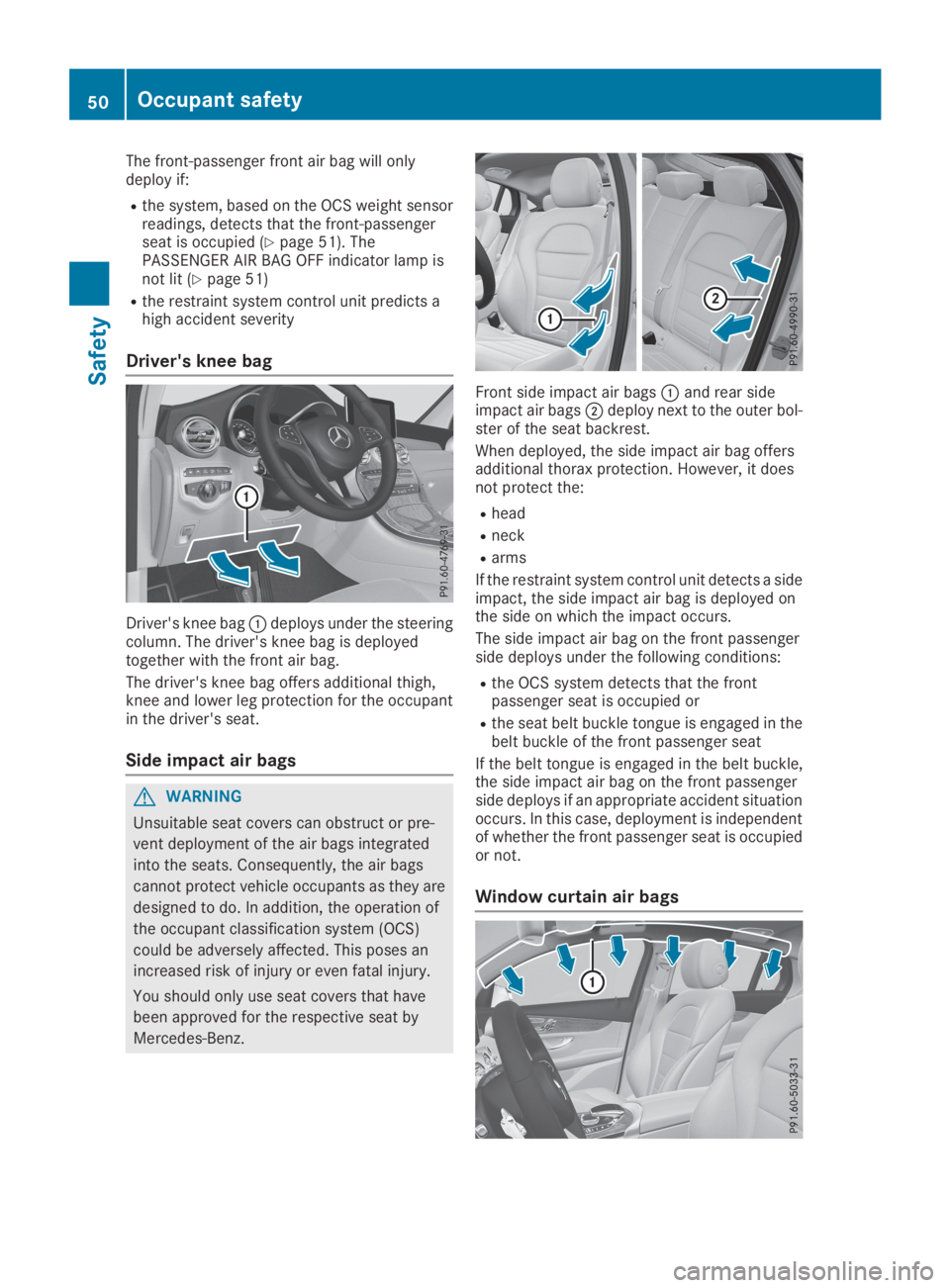
The front-passenger front air bag will onlydeploy if:
Rthe system, based on the OCS weight sensorreadings, detects that the front-passengerseat is occupied (Ypage 51). ThePASSENGER AIR BAG OFF indicator lamp isnot lit (Ypage 51)
Rthe restraint system control unit predicts ahigh accident severity
Driver's knee bag
Driver's knee bag�Cdeploys under the steeringcolumn. The driver's knee bag is deployedtogether with the front air bag.
The driver's knee bag offers additional thigh,knee and lower leg protection for the occupantin the driver's seat.
Side impact air bags
GWARNING
Unsuitable seat covers can obstruct or pre-
vent deployment of the air bags integrated
into the seats. Consequently, the air bags
cannot protect vehicle occupants as they are
designed to do. In addition, the operation of
the occupant classification system (OCS)
could be adversely affected. This poses an
increased risk of injury or even fatal injury.
You should only use seat covers that have
been approved for the respective seat by
Mercedes-Benz.
Front side impact air bags�Cand rear sideimpact air bags�Ddeploy next to the outer bol-ster of the seat backrest.
When deployed, the side impact air bag offersadditional thorax protection. However, it doesnot protect the:
Rhead
Rneck
Rarms
If the restraint system control unit detects a sideimpact, the side impact air bag is deployed onthe side on which the impact occurs.
The side impact air bag on the front passengerside deploys under the following conditions:
Rthe OCS system detects that the frontpassenger seat is occupied or
Rthe seat belt buckle tongue is engaged in thebelt buckle of the front passenger seat
If the belt tongue is engaged in the belt buckle,the side impact air bag on the front passengerside deploys if an appropriate accident situationoccurs. In this case, deployment is independentof whether the front passenger seat is occupiedor not.
Window curtain air bags
50Occupant safety
Safety
Page 59 of 370
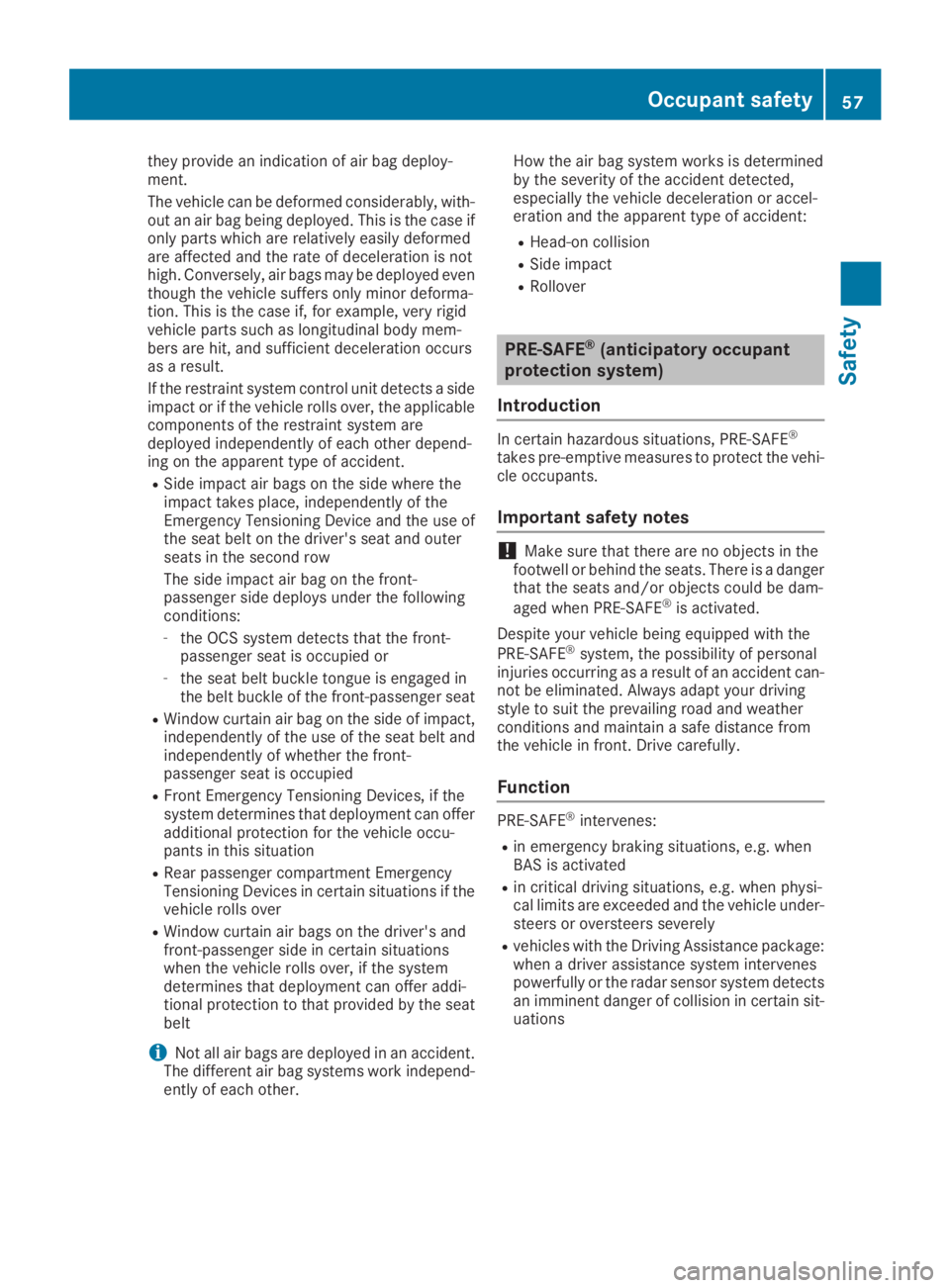
they provide an indication of air bag deploy-ment.
The vehicle can be deformed considerably, with-out an air bag being deployed. This is the case ifonly parts which are relatively easily deformedare affected and the rate of deceleration is nothigh. Conversely, air bags may be deployed eventhough the vehicle suffers only minor deforma-tion. This is the case if, for example, very rigidvehicle parts such as longitudinal body mem-bers are hit, and sufficient deceleration occursas a result.
If the restraint system control unit detects a sideimpact or if the vehicle rolls over, the applicablecomponents of the restraint system aredeployed independently of each other depend-ing on the apparent type of accident.
RSide impact air bags on the side where theimpact takes place, independently of theEmergency Tensioning Device and the use ofthe seat belt on the driver's seat and outerseats in the second row
The side impact air bag on the front-passenger side deploys under the followingconditions:
-the OCS system detects that the front-passenger seat is occupied or
-the seat belt buckle tongue is engaged inthe belt buckle of the front-passenger seat
RWindow curtain air bag on the side of impact,independently of the use of the seat belt andindependently of whether the front-passenger seat is occupied
RFront Emergency Tensioning Devices, if thesystem determines that deployment can offeradditional protection for the vehicle occu-pants in this situation
RRear passenger compartment EmergencyTensioning Devices in certain situations if thevehicle rolls over
RWindow curtain air bags on the driver's andfront-passenger side in certain situationswhen the vehicle rolls over, if the systemdetermines that deployment can offer addi-tional protection to that provided by the seatbelt
iNot all air bags are deployed in an accident.The different air bag systems work independ-ently of each other.
How the air bag system works is determinedby the severity of the accident detected,especially the vehicle deceleration or accel-eration and the apparent type of accident:
RHead-on collision
RSide impact
RRollover
PRE-SAFE®(anticipatory occupant
protection system)
Introduction
In certain hazardous situations, PRE-SAFE®
takes pre-emptive measures to protect the vehi-cle occupants.
Important safety notes
!Make sure that there are no objects in thefootwell or behind the seats. There is a dangerthat the seats and/or objects could be dam-
aged when PRE-SAFE®is activated.
Despite your vehicle being equipped with the
PRE-SAFE®system, the possibility of personalinjuries occurring as a result of an accident can-not be eliminated. Always adapt your drivingstyle to suit the prevailing road and weatherconditions and maintain a safe distance fromthe vehicle in front. Drive carefully.
Function
PRE-SAFE®intervenes:
Rin emergency braking situations, e.g. whenBAS is activated
Rin critical driving situations, e.g. when physi-cal limits are exceeded and the vehicle under-steers or oversteers severely
Rvehicles with the Driving Assistance package:when a driver assistance system intervenespowerfully or the radar sensor system detectsan imminent danger of collision in certain sit-uations
Occupant safety57
Safety
Z
Page 61 of 370
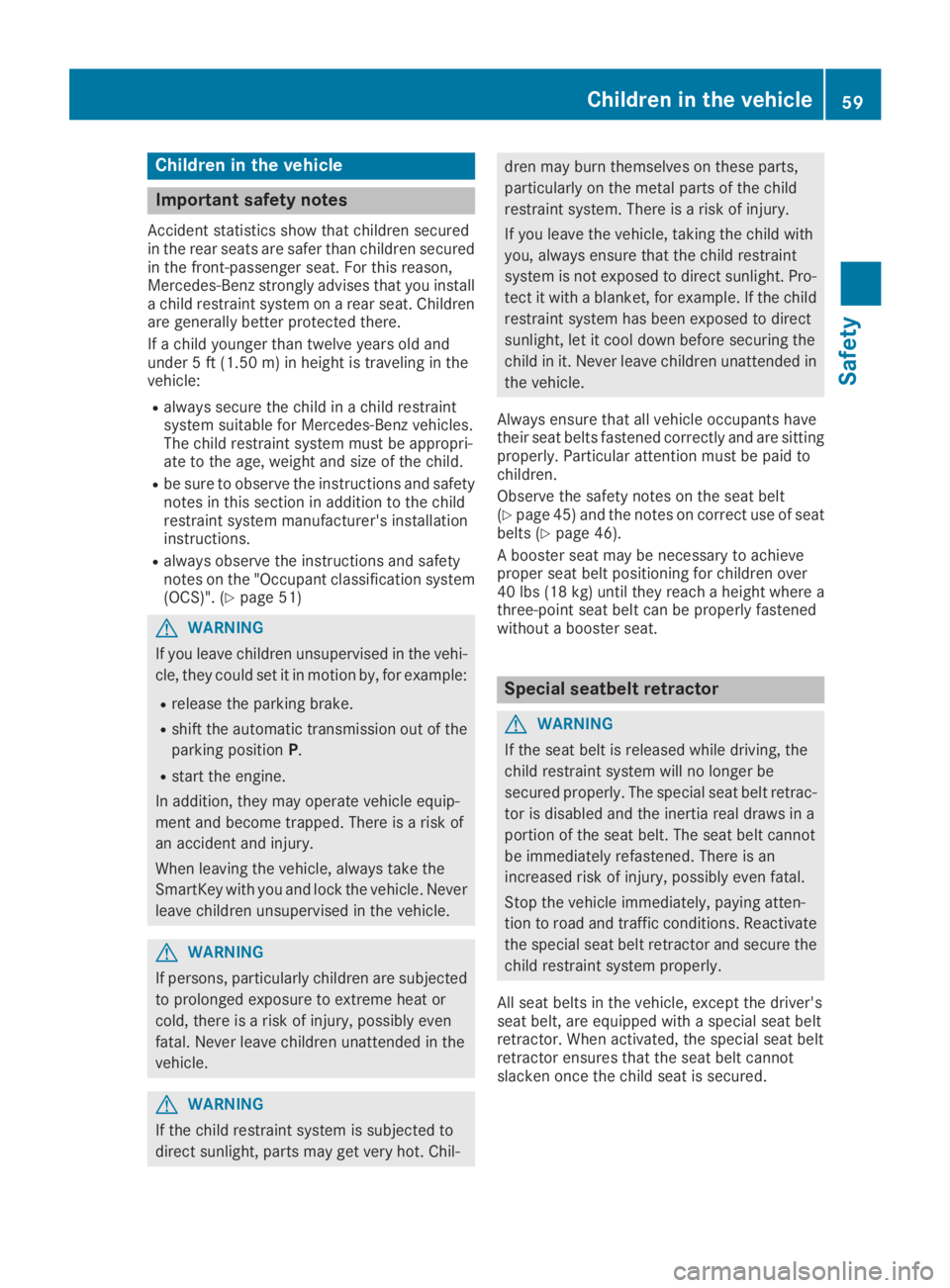
Children in the vehicle
Important safety notes
Accident statistics show that children securedin the rear seats are safer than children securedin the front-passenger seat. For this reason,Mercedes-Benz strongly advises that you installa child restraint system on a rear seat. Childrenare generally better protected there.
If a child younger than twelve years old andunder 5 ft (1.50 m) in height is traveling in thevehicle:
Ralways secure the child in a child restraintsystem suitable for Mercedes-Benz vehicles.The child restraint system must be appropri-ate to the age, weight and size of the child.
Rbe sure to observe the instructions and safetynotes in this section in addition to the childrestraint system manufacturer's installationinstructions.
Ralways observe the instructions and safetynotes on the "Occupant classification system(OCS)". (Ypage 51)
GWARNING
If you leave children unsupervised in the vehi-
cle, they could set it in motion by, for example:
Rrelease the parking brake.
Rshift the automatic transmission out of the
parking positionP.
Rstart the engine.
In addition, they may operate vehicle equip-
ment and become trapped. There is a risk of
an accident and injury.
When leaving the vehicle, always take the
SmartKey with you and lock the vehicle. Never
leave children unsupervised in the vehicle.
GWARNING
If persons, particularly children are subjected
to prolonged exposure to extreme heat or
cold, there is a risk of injury, possibly even
fatal. Never leave children unattended in the
vehicle.
GWARNING
If the child restraint system is subjected to
direct sunlight, parts may get very hot. Chil-
dren may burn themselves on these parts,
particularly on the metal parts of the child
restraint system. There is a risk of injury.
If you leave the vehicle, taking the child with
you, always ensure that the child restraint
system is not exposed to direct sunlight. Pro-
tect it with a blanket, for example. If the child
restraint system has been exposed to direct
sunlight, let it cool down before securing the
child in it. Never leave children unattended in
the vehicle.
Always ensure that all vehicle occupants havetheir seat belts fastened correctly and are sittingproperly. Particular attention must be paid tochildren.
Observe the safety notes on the seat belt(Ypage 45)and the notes on correct use of seatbelts (Ypage 46).
A booster seat may be necessary to achieveproper seat belt positioning for children over40 lbs(18 kg) until they reach a height where athree-point seat belt can be properly fastenedwithout a booster seat.
Special seatbelt retractor
GWARNING
If the seat belt is released while driving, the
child restraint system will no longer be
secured properly. The special seat belt retrac-
tor is disabled and the inertia real draws in a
portion of the seat belt. The seat belt cannot
be immediately refastened. There is an
increased risk of injury, possibly even fatal.
Stop the vehicle immediately, paying atten-
tion to road and traffic conditions. Reactivate
the special seat belt retractor and secure the
child restraint system properly.
All seat belts in the vehicle, except the driver'sseat belt, are equipped with a special seat beltretractor. When activated, the special seat beltretractor ensures that the seat belt cannotslacken once the child seat is secured.
Children in the vehicle59
Safety
Z